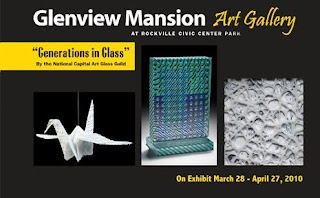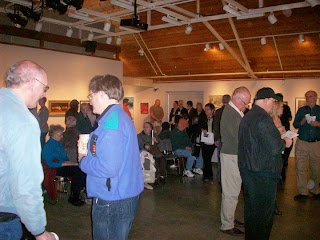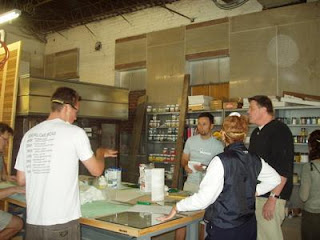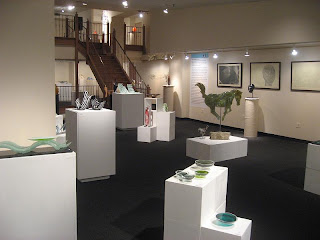>
Even befor the term “Post-craft Art” a New York based writer William Warmus described the “end” of the Studio Glass Movement – way back in 1995. The following essay appears on William’s website and this essay appeared in Glass magazine, Autumn, 1995
The End?
Studio glass has its beginning and end in America, where the present situation offers opportunities in two directions. Looking back, historians have an obligation to write the history of studio glass and establish its key figures, its first wave. Looking to the future, artists have the opportunity to incorporate the technical legacy of studio glass into new narratives.
Studio glass is at a pivotal point in its history. The recognition of established masters including Tom Patti and Dale Chihuly (the alpha and omega of technique and marketing), Richard Marquis and Dan Dailey (our humorists), Paul Stankard and Mark Peiser (pioneering naturalists), Howard Ben Tre, Mary Shaffer and Marvin Lipofsky (all sculptors) and the increasing attention paid to their work by writers, museums and collectors indicates the passing of the era of isolated innovation within the field. First wave work has the fresh, innocent quality typical of profound innovation and when the history of studio glass is written, the period from roughly the founding of the Glass Art Society in 1971 into the late 1980s will be theirs as originators and educators. And as innovators, they became the ones to challenge.
Originally, the concept of the glass artist working alone in the studio made sense as a way of moving beyond the meaningless and unproductive traditions that Harvey Littleton and others sought to escape, as they existed in the confines of the 1950s glass factory, which had become highly commercialized and unresponsive to artist’s needs. This led to a period of intense technical and stylistic innovation as studio glassmakers slowly reinvented the factory concepts of continuous technical experimentation, teamwork, efficient organization of space, refinement through repetition. Now the early masters of studio glass have become the champions of its traditions. The criticism leveled against many of these artists–that they do not change–no longer seems valid as time reveals the diversity of work produced during their careers. Significantly, these pioneering figures may now be seen as justified in consolidating their positions: they almost have a duty to perfect and publish techniques that took decades to refine.
We have perhaps forgotten that studio glass is largely about technique and broadening the definition of the factory: although it began in the United States as a way to get the creative glassmaker out of industry and into a pristine studio, it was also a way to put the artist back in control of techniques and some kind of factory. Today artists like Dale Chihuly and Dan Dailey are the direct heirs to Tiffany and Galle who, in the words of Harvey Littleton, “were trained as artists and had chosen glass, but [who] chose to work within the framework of factories that they founded, factories that were totally under their control so that they made very exciting things”. This is why studio glass begins and ends in America, where glassmakers first felt expelled from industry and where many now control their own homemade factories.
Most art movements last only a generation and the styles grouped together under the term studio glass are not exempt. Exceptional is the fact that new waves of studio glassmakers and collectors often behave as if their world will continue to evolve at the rapid pace set by the early innovators. This leads to the marketing of “innovations” that repeat, sometimes unknowingly, the early successes of the first wave. The terrain of studio glass is only now being charted, its circumference and boundaries measured, our susceptibility to imitations lessened. Criticism of glass exists, but is sporadic and tends to be published in specialized journals. We need forceful criticism as a gauge of originality and corrective to excesses, whether of taste, price, or commercialism. Forget the endlessly distracting quarrels over “Is it Art?” We need critics and historians to engage in the debates from which consensus will emerge about the key artists and objects of the studio glass era, even if some turn out to be industrial designers, some objects made by production studios. And we desperately need critics who will generously champion and defend the individuals they support.
I would venture to suggest that when the history of studio glass is written, significant accomplishments will include the growth of a community, the emergence within this community of innovative approaches to the marketplace, and the cultivation of maximum diversity within the medium itself.
Communities grow from a mixture of common attributes and interest, and I challenge readers to find any art communities that are more unified than the one focused on glass. As the American art scene expanded from the 1960s onward it became increasingly difficult to capture the sense of community shared by earlier groups such as the abstract expressionists, unified by location (New York and the Hamptons), dealers (Peggy Guggenheim), collectors, and critics (Greenberg and Rosenberg). The current art situation mirrors the present political situation in the United States: it is too diverse and factional to be called a community in the traditional sense. But the glass world, the glass ghetto so disparaged in some circles, is not. It has remained a community on the order of the earlier ones that are now disbanded. That is something to celebrate, not dismiss and discourage. If you are an insider and have forgotten the warmth of individual members and the strength of the crowd, or a newcomer and want to see for yourself, visit any of the great gatherings of the clan (the phrase of one prominent critic): the October Pilchuck School benefit auction, the springtime Glass Art Society conferences, the great exhibition and collector reunion at SOFA Chicago every fall.
The market for studio glass matured from roughly 1979-1989, led by legendary dealers, notably Ferdinand Hampson and Douglas Heller, who in many ways took the place of art critics as promoters of the “new glass”. In my mind, the key innovation in this market was the development of a close knit and highly involved community of collectors on a national (not regional) scale, unlike anything in the artworld, who for many reasons found that they enjoyed each other’s company, enjoyed taking glassblowing lessons, founding philanthropic societies to support emerging artists, etc.. Many were couples who collected as a means of enhancing a relationship, and many collectors were successful business people who brought a benignly competitive approach to acquiring studio glass.
Since 1990, stagnation has been evident. Many of the founding collectors have built large, mature collections and consequently are less active. Impersonal forces, primarily discounting and studio sales, drive the nineties market and have taken the lead away from pro-active dealers and collectors: who are the new Hampsons, Hellers and Saxes of the nineties? What are the bold moves, such as opening a gallery in SoHo or energizing a major art museum (Toledo) to renew its support for contemporary glass? There are certainly signs of optimism, as some members of the new generation of studio glassmakers have been able to raise their prices by showing in a fine arts context where prices are traditionally higher. But should we be optimistic that the studio glass community and market is increasingly driven by external forces, and no longer by its own internal momentum, which now seems dissipated?
Art communities are defined more by shared aspirations than shared achievements, which tend to be recognized as individual. As leading figures in studio glass achieve national attention and distance themselves from their origins, the aspirations of the community become diffused and susceptible to sentimentalizing. Now, as younger artists working with studio glass techniques develop stronger roots in the art world, signs of disintegration are only emphasized. Their aspirations lie elsewhere, as may their community ties. This is inevitable: communities are destined to dissolve or evolve. And while the ever present fear in political communities, republican or democratic, is that they will succumb to tyranny, art communities might rightly fear more the effects of neglect and marginalization. The pond may be drying up.
The glassmakers who came after the first wave and matured in the 1980s, as well as those now entering the field, face a daunting situation. Stagnation, exhaustion and lack of direction are words applied in the 1990s not only to studio glass, but to all aspects of life in the United States. The end of the cold war has unmasked the decay of moral values in nations on both sides of the iron curtain. Artists, aware of the changes within society, have documented this corruption. Pathological art, art about the sickness of society, has replaced the avant-garde art in the mainstream. Are we witnessing the desperate end of an era, or a stillborn birth?
Studio glass itself is not stagnant, it is complete. There is an uncanny parallel between the development of studio glass and of glass blowing in ancient Rome. As Donald Harden noticed, in writing for The Glass of the Caesars, “There must have been some experimenting before glass-blowing became accepted and well understood by glassworkers… but …within twenty or thirty years they proved capable of developing almost all the inflation techniques still present nearly 2,000 years later in the workshops of their modern successors.” I believe the argument can be made that the period of innovation in studio glass, roughly from 1962 through the end of the nineteen eighties, was the most significant period in the history of glass since Roman times.
The significance of studio glass may be its cultivation of and openness to diversity, not in an ethnic sense but in a technical, material one. The preserve of glass is everywhere, not just in the artworld. Sometimes it seems that glassmakers make things for no reason at all except the technical challenge, but in fact studio glassmakers are willing heirs to a long and mixed tradition of craftmakers, artists, souvenir shops, anomalous extra-artistic stuff, stuff so beautiful or unusual or peculiar that glass has become a loose cannon among media: it is unpredictable how any glass object will be appreciated once it is made. The unpredictable beauty inherent in glass means that an extreme surplus of value may at any moment be attached to any object: a factory made souvenir or the damaged 200 inch telescope mirror blank on display at The Corning Glass Center. This suggests that some of the best works in glass are not necessarily magnificent works, but those that inspire magnificently. These may be turned out by many different kinds of studios, and it is the willingness of many to accept this diversity that has kept the community vital.
Will another 2,000 years be required before the word new can again be applied to glass making? The confused and incomplete styles of art we see emerging from glass studios today are indicative of experimental, transitional, rococo and mannerist work that, in moving away from studio glass traditions, has yet to establish its own identity. Some of the best work has simply taken its place in the art world in general and is unrecognizable as studio glass: Christopher Wilmarth, never a studio glassmaker, led the way in this direction.
Despite the success of Duchamp’s “Large Glass,” glass as a material for art has never been comfortable in association with the avant-garde or its pathological successors (even Galle, the sickliest of glassmakers, asserted the vitality of nature through his symbolism). Art glass that imitates the look and actions of the avant-garde appears immature and kitschy or stale and pompous. Maybe glass is too inherently healthy, glassmakers too accepting of diversity, to fully participate in the current art scene. Tiffany and Galle may yet emerge as more central to glass than Duchamp or neo-expressionism.
Perhaps the most promising glassmakers are now renovating venerable glassmaking traditions by producing vessels and figures within a narrative art that has links to traditional storytelling. Maybe the word renovation will come to replace the word deconstruction as a mantra for the nineties. The interest in narration, in narrative art, is significant for renovation: retelling is a means of renewal. Narration promises to be the tool that is added to the “technical” tools developed by studio glassmakers over the last 30-odd years, a tool that is necessary for retrieving lost legacies and for opening up future horizons. As Paul Ricoeur, the essential philosopher of narrative, wrote: “Making and narrating have become the two sides of one process.”
Today, making glass and narrating are the two sides of one process. Yet narrative studio glass should not be weakened by narrowing its definition to a sort of three-dimensional storytelling or by appropriating to itself the roles of painting and sculpture as documentarians of the pathological and the unhealthy. The role of narrative in glass, like the role of telescopes in astronomy, should be nothing less than the humanization of time and space, so that we can make a home in the expanding universe. This project promises to establish for glass a role independent from the other arts.
William Warmus, Ithaca
June, 1995
For a link to William’s website essay:
http://www.warmus.us/The%20End%20essay%20Warmus.htm


























